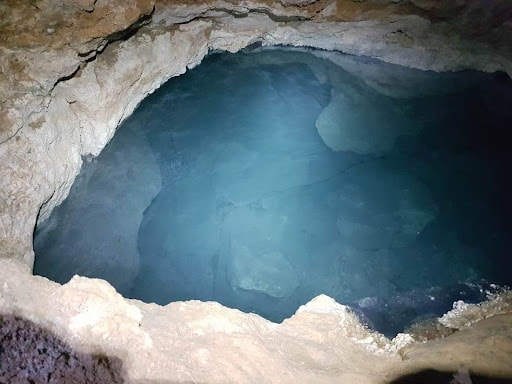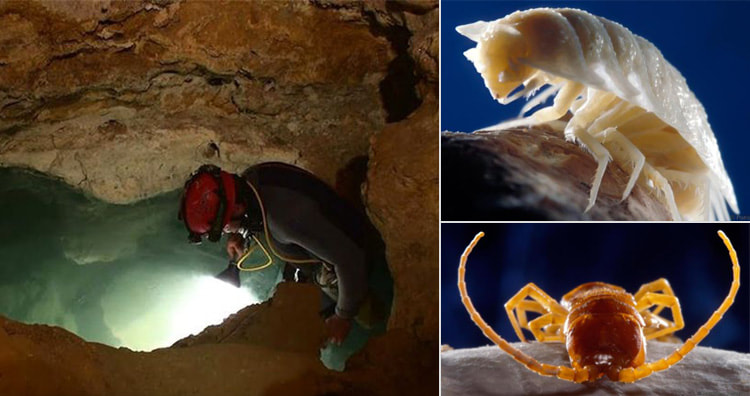|
Yesterday we spoke of light, so today seems to be a good time to explore darkness. Not the spiritual kind, but the actual lack of light kind. It comes to us all the way from Romania. And it was brought to my attention by my science-geek friend Brad Baker who suggested we get to know Movile Cave. Hidden underground in Southeast Romania (about 2 km from the shores of the Black Sea), Movile Cave went unnoticed for millions of years until it was accidentally discovered in 1986. Yes, while our primate relatives were trying to evolve into homo sapiens, there was a whole other world evolving below their feet. A world that is by far stranger than fiction in that it not only exists in total darkness, but has thrived unnoticed right below our feet. While you might be ready to abandon lockdown and get on the next flight out of town, this cave is not a very big tourist destination. And for good reason. For starters, it is relatively small and its narrow entrance is often blocked with a thick layer of clay that has kept sunlight, food, or water from passing through the surface. While this has help keep the cave at a steady temperature of 21 C, it has also kept all its residents separated from the outside world for about 5.5 million years. So I guess you could say it’s not very hospitable to humans. On the bright side (no pun intended) the place does boast a lake. But to get to it you have to worm your way through numerous narrow passages, including a few deep drops into total darkness. In other words, room is based on availability. If you are lucky enough to get in, bring an oxygen tank with you because the place reeks of rotten eggs and burnt rubber. That’s because its poisonous atmosphere has a very high concentration of hydrogen sulfide and carbon dioxide, and not a lot of oxygen. But for the adventurous traveler, Dr. Valentina Cetean tells us that Movile Cave is a collection of “gorgeous and spectacular labyrinthine galleries,” and should be “considered one of the greatest discoveries of the century that revolutionized the theories of life on Earth.” If you were so bold, or crazy, to visit inside the cave (no thank you), you would find a “stable and unique chemoautotrophic ecosystem” where the water contains “neither food particles, nor radioactive isotopes common in the soil of Romania after the Chernobyl accident.” Scientists believe the only explanation for its unique quality is that “the water from the cave isn’t coming from above, so it must be coming from 25,000 years old spongy limestones strata from below.” That also might explain the weird things that grow in the dark down there. Based on a paper in the Microbiome Journal, “The Movile Cave ecosystem hosts a diverse range of invertebrates (worms, insects, spiders and crustaceans) that are adapted to life in the dark.”
For those of you who like bugs and crawly things that can kill you, scientist have also identified 33 new species of bizarre creatures that have never before been seen by humans. In their dark, mysterious subterranean Eden there exists unique scorpions, spiders, woodlice, and centipedes who according to Cetean survive on a “frothy foam mat of autotropic bacteria that takes the energy from chemosynthesis (instead of photosynthesis).” Yummy, eh? If you were going for the fine cuisine, think again. This is the only thing this inhospitable hotel has to offer for room service. Unless, of course, you’re into eating bugs (which I have done in Peru and Korea). If you’re game for such a fare, the cave offers plenty of creepy-crawly, slithering things to munch on. “Small insects, pseudoscorpions and other invertebrates which are prey of the unique species of larger predators as spiders, snails, leeches, shrimps, centipedes or water scorpions.” Fun Fact: having lived in complete darkness for millions of years, most of the inhabitants in Movile Cave are blind, but have long appendages like antennae to help them feel their way around. Nearly all are colorless and have translucent skin. There are no flies, yet the spiders spin their webs to capture small insects called “springtails.” Scientist have discovered a venomous centipede that measures between 46 and 52 mm in length. David Nield notes, “Thinking of its top rank in this subterranean system, we decided to name the species Cryptops speleorex, which can be translated to the 'king of the cave'." I’m sure there is a lot more down there, in the dark. But unfortunately, one cannot stay down there for more than 5-6 hours at a time. So by the time you check in, it’s time to check out. For someone who does not do well in complete darkness, especially in cramped spaces riddled with things that can bite me, I can’t see myself going into Movile Cave. But I’m glad I got to know it, if only to know to avoid it now that travel restrictions are being lifted. Work Cited geoera.eu sciencealert.com Wikipedia Unbelievable-facts.com
0 Comments
Leave a Reply. |
Ian MacdonaldAn ex-copywriter turned punk rock pastor and peacemaker who dedicates his life to making the world a better place for all humanity. "that they all might be one" ~John 17:21“Prius vita quam doctrina.”
~ St. Thomas Aquinas (1225–1274) * “Life is more important than doctrine.”
Archives
June 2024
|

